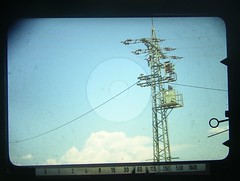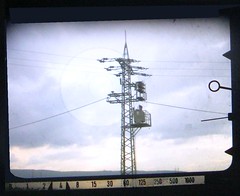Minolta SR-T 101
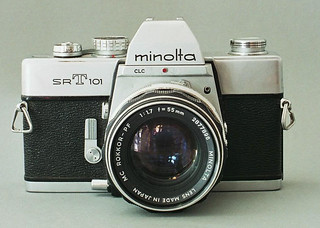
|
| image by Dries van den Elzen (Image rights) |
Contents
Introduction
The Minolta SR-T 101 is a 35mm SLR camera made by Minolta Camera Co. Ltd, Japan, premiering in the March 1966 Japan Camera Show [1]. Sales began in April 1966 and it stayed in production with only minor changes for ten years, the result of the thorough development effort that was put into the camera. The body is a direct continuation of the Minolta SR-7 model V of 1962, itself an innovative camera.
However, the SR-T 101 is a leap forward from the SR-7. Perhaps the most notable new feature was the full aperture metering facility, a feature it took Nikon twelve more years to figure out how to accomplish. Full aperture metering in 35mm SLR cameras was pioneered by the brilliant Tokyo Kogaku Topcon RE Super, and would not appear in a screw mount camera until Olympus Kogaku introduced the Olympus FTL, their first full frame 35mm SLR in 1971, which was abandoned one year later in favour of the OM system. For a time, Minolta dominated this area of camera design.
The technical requirements of full-aperture TTL metering led to a new variation of the SR mount, the MC mount (for "meter coupling.") This system involved the same bayonet mount, but added a tab on the aperture ring to directly signal the aperture (relative to the maximum aperture) set on the lens. SR mount lenses are generally usable in unmetered-manual mode on MC mount cameras, but some automatic-diaphragm lenses made before 1961 have compatibility issues with the diaphragm coupling. MD lenses made later add a second tab to signal X-series cameras that shutter-speed priority is available, and these lenses are backwards-compatible with the MC cameras such as the SR-T series.
The first generation camera body serial numbers started from 1000xxx (see section below). When first introduced, the standard kit lens was the 58mm/f1.4 MC Rokkor-PF, with 6 elements in 5 groups, beginning from lens serial number 5000xxx. About four months after launch, the 55mm/f1.7 MC Rokkor-PF, 6 elements in 5 groups, was added as an alternate kit lens. Then in September 1968[2], the 58mm/f1.2 MC Rokkor-PG, 7 elements in 5 groups with 8 aperture blades, became available. These earlier kit lenses featured knurled metal barrels, versus later rubber-gripped MC Rokkor-X (or MC Rokkor) versions. A very well crafted ever-ready case was available in either brown or black leather to protect the camera with normal lens. A longer-nosed black ever-ready case was made for the SR-T101 and 58mm/f1.2 combination.
The SR-T series subsequently included many models, all of them variations on this body. Most of these were budget models lacking some of the special features of the top-range SR-T models; many of them lack the shutter-speed indicator, for instance.
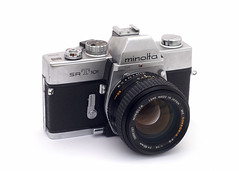
|
| image by Steve Harwood (Image rights) |
Physical description
The SR-T 101 is a somewhat blocky camera by modern standards, but it represents a school of industrial design that was ahead of its time in the mid-60's. The camera is quite typical in its physical layout, with the shutter speed dial, film advance and rewind knob mounted on top and the battery compartment, meter on/off/battery check switch and rewind-release button on the bottom plate.
The film advance can be operated in one strokes or multiple, whichever is more convenient. The lever goes quite far forward when operated in one stroke.
Other controls are on the sides of the lens mount; on the earlier SR-T 101's, these controls are a depth of field preview button which stops down the aperture (this locks in place on the SR-T 101 but not on some later models) and a mirror lock-up knob, mainly provided to make the camera compatible with ultra-wide angle lenses. On the other side of the lens mount, there are PC sockets for FP and X sync (FP refers to long-burning flashbulbs that can be used at speeds higher than 1/60th of a second, as their output remains constant over the amount of time it takes for the focal-plane slit to travel). The lens release is on the front of the lens mount; it is a knurled knob that must be pushed diagonally towards the lens to release it.
Around the lens mount is a spring-loaded ring that travels with a stud on the aperture ring (or a stud linked to the aperture ring, in the case of some longer lenses where the aperture ring is not adjacent to the camera.) This tells the camera how many stops below the maximum aperture the lens is set to, and allows the camera to meter at maximum aperture.
On the back is a rotating film reminder labelled in both ASA (ISO) and DIN.
Shutter
The shutter is a conventional, fully-mechanical rubberized-cloth focal plane shutter with speeds from 1/1000th to 1 second. The camera lacks the mechanical provision to double-expose by holding the rewind release and cocking the shutter, but later models would add this feature. It may be possible to double-expose by pressing and holding the rewind release and holding the rewind knob, but it seems this is exceedingly difficult to do without moving the film somewhat, and would likely take two people to accomplish with ease and accuracy.
The shutter, like the aperture-sensing ring, is connected to the follower needle in the viewfinder, not as in some match-needle cameras, the meter needle itself. It is also connected to a sliding bracket in the lower part of the viewfinder that indicates the current shutter speed.
There is a self-timer, of the same kind as on the Pentax Spotmatic, for instance. It is a lever which is wound up by hand and released by a small button above it.
Viewfinder
The SR-T has an extremely bright finder, owing to its large, double-hinged mirror. The ground glass has a central micro prism focusing aid that proves to be very accurate in most cases, since even when no visible lines are present in the subject, all out-of-focus objects appear to shimmer. Some later models replace this with a microprism ring around a split-image device. The meter and follower needles are shown at the right and the selected shutter speed is at the bottom. A small rectangle by the needles indicates the battery charge; if the meter needle is somewhere over this rectangle when the switch is set to BC (Battery Check), the battery is in the acceptable range.
This bright, feature-packed viewfinder would prove to be a high point of Minolta SLR's, and the SR-T series would preserve the bright finder throughout; some, such as the SR-T Super (sold in North America as the 102) would add a "Judas window" above the image to show the current aperture (though it would not work with all lenses or in dim light.)
Metering: CLC and full aperture TTL
Camera ads from the 1970s boast of its CLC (Contrast Light Compensator) metering, calling it "the brain". CLC is a form of TTL metering with two CdS cells. If there is high contrast between the two, it compensates by assuming that the upper side of the picture is the sky and that the lower part is the subject you want to photograph. ISO values can be set from 6 to 6400. The meter is the only battery-powered component; it takes an obsolete PX625 mercury battery, banned in most countries other than Russia, but workable alternatives are readily available.
| viewfinder |
|---|
|
The SR-T 101's viewfinder shows the exposure meter needle at the right side of the finder image. This needle shows the actual light value coming in through the lens at maximum aperture, with lower indicating a higher light value. The needle's position is not dependent on film speed or any other camera setting; it will be constant for a given light value and a given lens. Also at the right is a follower needle with a circle at the tip. This indicates the current exposure value calculated from film speed, number of stops below maximum aperture, and shutter speed. By changing one or more of these inputs, this circle can be made to overlap the meter needle, at which point the exposure will be approximately correct. The second image shows the meter in battery control mode: needle over the little rectangle means correct voltage. |
The Minolta SR-T 101 was one of the first cameras to have full aperture TTL metering. This was possible thanks to the fact that Minolta had placed the aperture ring on its Rokkor MC lenses close to the camera body. This way, the position of the aperture ring could be communicated mechanically to the metering system inside the camera. What is actually transmitted is not the aperture itself, but the offset between the selected aperture and the lens' maximal aperture.
Repair
Several internal parts may fail on a forty-year-old camera, and the SR-T 101 is no exception. The most serious trouble is related to the exposure meter movement, in which the tiny coil can break; this situation requires a replacement. The back door rubber sealing foam will usually need replacement, and so will a small strip of same cushioning the mirror when it goes up. A strip of this may be cut from a similar sealing material from a hardware store. Many other problems can be solved by removing the top (which is somewhat difficult) and putting right the strings and pulleys that communicate aperture and shutter speeds.
The shutter can easily be accurate after all this time, especially on later examples, though it is, of course, also common for the slow speed timer to jam, resulting in all slow speeds being equal to 1/60th.
How old is my Minolta SR-T 101?
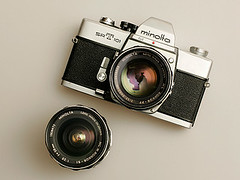
|
| First version SR-T101 (note shutter speed dial) image by Siim Vahur (Image rights) |
During the ten-year manufacturing period of the Minolta SR-T101, many small changes were made to the camera body. Several of these changes are easily detected and they can help determine time of manufacture to within a few years. It should be noted that any part of a camera may be replaced due to repair and smaller parts are more easily swapped, but normally these features may be considered original. Top cover and base plate are parts usually replaced due to impact damages, and a replacement top cover would not have the original serial number.
1966-late 1969: the first generation 101’s have a finely-knurled black shutter speed barrel (even on chromed body models), and have single slot screws holding the base plate and top cover on, while later generations use Phillips head screws. From 1966 into 1967, the two screws at the back of the top cover were the same distance from the eyepiece, while on all later SR-T‘s the right-hand screw is farther away from the eyepiece. From 1968 on, the black plastic shoulder pieces between the front cover and the top cover are held in place by visible screws. In Fall 1968 Minolta began selling black body SR-T101's, like image at left, from serial number 1270xxx on.
1970-1973: the second generation and later 101’s have a coarse ridged chromed shutter speed barrel. From 1972 on, as seen on the inside of the top cover, the film counter clear plastic window is glued in place, while on earlier versions it is held in place by an internal bracket.
1973-1975: on the third generation 101’s, the black plastic piece under the accessory shoe protrudes up forming a ridge in front of the shoe, while earlier versions have a single metal peg. This would be the design used when the shoe was replaced with a hot shoe on later models.
The lack of mirror lockup (MLU) on an SR-T101 is not an exact indicator of its age. MLU first began to be discontinued early in the transition to the second generation, but did continue at least until the third generation SR-T.
Legacy
The Sr-T 101 began a long-lived, commercially-successful and lauded series consisting of incremental upgrades of this body, as well as affordable budget models lacking some features. The most common variation, sold under various model numbers, removes the mechanically-complicated shutter-speed indicator and the self-timer; variants with and without hot shoe and even a variation with single-cell (non-CLC) metering exist within this budget range. The SR-T Super (sold as SR-T 102) and its successors would add a Judas window for the aperture ring, thus showing all the exposure information in the viewfinder. Some models, such as the super) add a split-image device, and some models were made with either focusing screen. The last model, the SR-T 100X was launched in 1979, thirteen years after the original 101.
Technical specifications
- Type: 35mm Manual-focus SLR
- Manufacturer: Minolta
- Lens mount: Minolta MC (backwards-compatible with some SR, forwards-compatible with MC)
- Shutter: Focal-plane shutter, fully mechanical, cloth
- Shutter speeds: 1s-1/1000s, B.
- Flash sync: PC socket for FP (theoretically any speed) and X (at 1/60th), cold shoe
- Exposure: Metered-manual (match needle), CLC dual-cell system, battery operated.
- Battery: PX625, for meter only
- Viewfinder: Reflex finder with microprism focusing spot, match-needle system and battery check, shutter-speed indicator.
Notes
Links
- Minolta SR-T series; an overview of features.
- Review at Classic Cameras
- Rokkor files
- SR-T 101 Manual (JPEG Scans)
- SRT-101, SRT-101 noir, SRT-101b on www.collection-appareils.fr by Sylvain Halgand (in French)
- Minolta SR-T 101 page at Camera Portraits
- Minolta SR-t 101 camera manual, German version available, repair manual from OrphanCameras.com
| Minolta Classic Cameras |
|---|
| Vest (or Best) | V2 | SR-2 | SRT 101 | XE | XD | CLE | 7000 | 9000 | 800 si |
